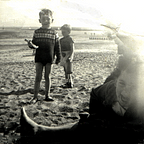The First World Cup
The 1930 ‘football Olympics’ turned into one of the crazier Ted Lasso episodes.
At their 1928 Congress, FIFA members voted to introduce a new tournament, open to all member countries. This ‘football olympics’, named after FIFA President, Jules Rimet, would also take place every four years. The first tournament would be held in Montevideo in honour of Uruguay, the then Olympic champions. All FIFA member were invited to participate.
The European delegates (minus those from the English FA) cheered this bold plan. Then their accountants reminded them that getting to Montevideo would involve a long sea journey and considerable expense.
“We’ll pay for your accommodation,” the Uruguay FA promised as the apologies piled up. Later, with increasing desperation they offered to cover the travel costs too.
Slow boat to Montevideo
By the deadline, thirteen countries had accepted the invitation to participate. Seven were from South America: Argentina, Bolivia, Brazil, Chile, Paraguay, Peru & Uruguay. Mexico & the USA represented Central & North America.
Only four countries came from Europe: Belgium, Roumania, Yugoslavia and France. The Roumanian party consisted of eleven players plus a super-fan: King Carol. His royal highness was the official team manager — the authorities being more relaxed about coaching badges at that time
The four teams travelled together to Montevideo, a voyage lasting several weeks. The French travelled first class. The others squads could only afford third class travel, though doubtless King Carol had a comfortable cabin.
All the players trained together on the deck of the boat.
Somehow all the teams scheduled to play arrived in Montevideo in July 1930. With squads and staff severely restricted only there was much multi-tasking.
The US manager doubled as an assistant referee and team physio. In the latter role, he came on the pitch to treat one of his players. Somehow, he managed to drop the bottle of chloroform he was carrying. When he bent down to pick it up he inhaled the fumes, knocking himself unconscious. This required a second ‘physio’ to come on to cart him from the pitch.
Generally team registration protocols were astoundingly loose. The USA squad was bolstered by several English players, with no known connection to the country they were appearing for.
Thirteen is not an ideal number of teams for a tournament, but the organisers showed admirable ingenuity by dividing it into three stages.
The first was A mini-league involving all thirteen teams. The top four — Uruguay, Argentina, USA & Yugoslavia qualified for knock-out semi-finals.
All the matches were scheduled to be played in the newly built Estadio Centenario — in Montevideo. Unfortunately, however, this was not completed until five days into the tournament so two more venues were quickly arranged.
Early fixtures not involving the home nation excited limited local interest. The first official World Cup match between France and Mexico took place in front of just 3,000 spectators. France won 4–1. A match between Peru and Romania attracted 300 — the lowest attendance in World Cup history.
There were no television or film cameras present to record Luicent Laurent’s 19th minute goal, the first in World Cup history.
No VAR
France’s early success proved fleeting. They went out at the group/league stage, after losing to Argentina in very strange circumstances.
With 84 minutes played the referee blew the final whistle with the score at 1–0 to Argentina. The players trooped off to their dressing rooms, perhaps aware that the second half had felt a little short but being too polite to comment(the tradition of surrounding the referee and doing a mime show to express grievance had not yet been established).
A FIFA official then began completing his match report — and realised that the match had ended six minutes early.
“You’ll have to get back out,” he told the referee. “Otherwise the game has been abandoned and will need to replayed.”
Some players were already in the bath when the red-faced ref informed them problem. Nonetheless they dutifully dried themselves off, got back into their kit and returned to the pitch.
The remaining minutes were played without further score. France were out — with only a first-class sea voyage back across the Atlantic to look forward to.
First final — first shock result
On 30 July 1930 the First World Cup Final was a local ‘derby’ between Uruguay and Argentina. Controversy started before kick-off with a dispute over which ball to use. After a protracted discussion it was agreed to use the preferred Argentinian ball in the first half and the Uruguay one in the second.
In contrast to earlier fixtures, the Final attracted a huge crowd. An estimated 30,000 Argentinian fans crossed the River Plate, to form part of a crowd recorded at 93,000.
The game started badly for the Olympic Champions. Home supporters watched in near silence as Argentina took a first half. 2–1 lead.
But in the second half Uruguay came back for a famous 4–2 victory. They were the first World Cup winners.
1928 FIFA Congress — England out, World Cup in
